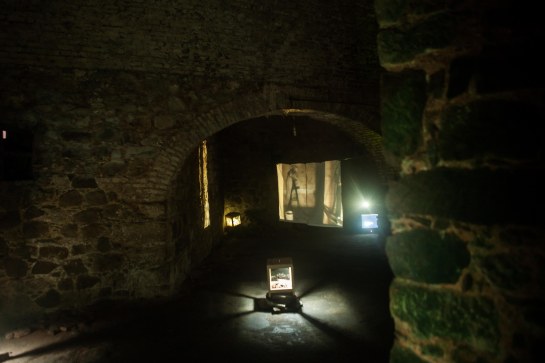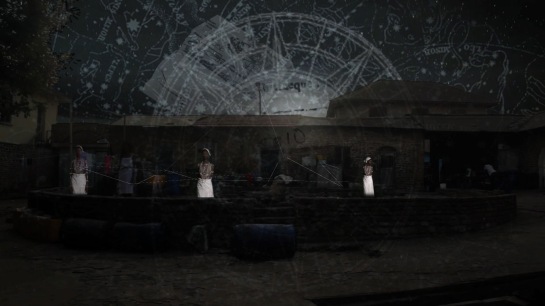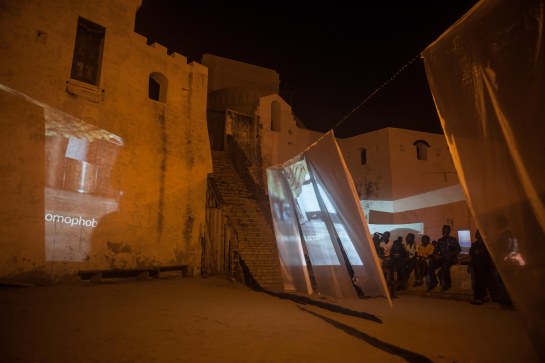I had a conversation with Johannesburg based artist and filmmaker, Kitso Lynn Lelliott, about the theoretical underpinnings, conceptual preoccupations, techniques, visual and display strategies which characterize her work. Full interview below.
IUB: What are the core subjects or questions raised in your work?
Kitso: Mmm…I may have been clear(ish) on the answer to this at some point in my practice and explorations, but at the moment its hard for me to say. I know we are supposed to always be perfectly clear and concise about what we do, yet I’m afraid I’m just not. I’m struggling with things at the moment. I suppose in some ways my questions are about being, ways of being, and ways of coming into being. I suppose there are multiple ontologies, but the one that is dominant in the space you occupy, the hegemonic, tells you that your space of being is questionable, that your humanity is questionable, that you are constituted by lack… despite one’s own embodied reality rendering such questions nil, void and utterly absurd – how does one find a space to be in such an environment? So my questions have to do with competing realities, ontologies, and how these determine one’s being and capacity to be/become. I imagine the comprehension of any ontological reality from the perspective of its other to be somewhat of an apparition, something beyond its reality, in another realm and thus ghostly. So I think through the ghostly in terms of the ways something from beyond the bounds of comprehension from any one perspective might appear, and how ghosts can interrupt on and be in spaces they are not supposed to be. Ghosts give me a way of articulating things that are where they are not supposed to be, where they are denied, as they don’t really abide by the parameters of being that are ascribed to them there.

Kitso Lynn Lelliott, “Sankɔfa Hauntings, Ghosts of a Futures Past” Installation view inside women’s dungeon of Cape Coast Castle, 2015 image by Desire Clarke
IUB: On ghosts, you have also said elsewhere that they “not only articulate the presence of something missing but also embody the violence in processes of eliding that produces them”, and that this violence is not only visceral (i.e. acted upon the body) but epistemological with deleterious effects on one’s consciousness (or a collective consciousness for that matter). What are the ways in which the ‘ghostly’, perceived in this sense as inhabiting a position of alterity (from the perspective of the other), manifest in your work?
Kitso: I suppose it’s a thing of questioning the idea of alterity as a static singular state of being in a way. I think the ghostliness or what I am describing as ghostly is dependent on the perspective that is perceiving it. Alterity from the perspective of hegemony is not (or not necessarily) alterity from oneself as I am both the centre of my own experience as much as I may be the marginalized outsider/denied being from the perspective of power. I suppose the ghostly lets me explore this simultaneity as well as trouble and bring some crisis to the ‘reality’ that would produce me as other in the first place.
I feel like there is some ambiguity in the question itself “alterity (from the perspective of the other)”… is this to say the ‘other’ of those who are socially and structurally othered? That is to say seeing from the perspective of the other, the marginalized, rendering the otherwise ‘normative’ as other? Or, alterity in reference to the those who are normatively othered?
But this “convolution” in the question itself starts to point to the things I am playing with in my work and conjuring of ghostly.
There is a woman in my work. She is kind of a ghost, an ancestor, a traveler through time who carries a lot of baggage with her. She is haunted herself, carrying the experience from her past lives with her while she time travels and troubles the futures that has come out of her experience. She appears in places that are tied up with processes of erasing her, her humanity, her agency and even presence. Her presence in these places insist on a reconfiguring of their narratives bringing their complicity in her dehumanization, and the dehumanization of those like her, to the centre of the narrative while her presence also denies the ability to erase her.
She is a ghost troubling a world where alterity is possible, a world where things that are not held within the bounds of hegemony’s normative can be denied, where people and their humanity can fall within or without the bounds of human. It’s a way of shifting the way of seeing that is privileged so that her/my being is no longer seen from the perspective of hegemony as an exotic, peculiar other somewhere beyond the realm of human — the image prescribed by hegemony’s discursive production of alterity — but rather a being described from where she is. A place where her difference from another, her other, does not render her peculiar, as she enunciates herself. So the ghost is just about being – being in ways and showing up in places where one is not supposed to be and owning it. Hegemony denies her and would make her a non being. But she is there, somewhere between her denial and her being, that struggle between absence and presence pointing to a tension between the hegemonic world as it is and a more inclusive world as she would re-make it. She troubles hegemony and the very idea of alterity I think…

Kitso Lynn Lelliott, Alzire of Bayreuth, 2015, video still, installation view inside Neues Schloss Bayreuth
IUB: What are some of the visual strategies and techniques that are used to articulate stories or ideas in your work as well as in exhibitions? For example, how do functions like repetition, loops, simultaneity and sound come together in the way you compose your moving images and installations?
Kitso: Repetition, or maybe something more closely resembling multiplicity can be seen in this woman who reappears through multiple avatars throughout a great deal of my videos. She is many versions of a subjectivity, a singular kind of entity but she is also porous and is refracted and reflected across multiple subjectivities. She is a marker of what they have in common. She has lived through many incarnations, in different places and different times, circumstances, realities and has a sense of how fickle ‘reality’ can be. I think each time she appears in a different guise or avatar she speaks to a different part of this subjectivity, but also across her own difference — between the different version of herself. So she will often appear in different ways in different videos in the same installation. The simultaneity and slippages between her various selves is a key strategy I think. Simultaneity, opacity and the poly/many/multiple and fragmentary.
She is a self that becomes in relation and is constantly becoming in relation and her constantly shifting presence in spaces and palaces shift those contexts that in turn are constantly shaping her. So there is a relational dimension to her constitution where she is simultaneously shaping the world as it shapes her. She exists in a sense of a loop, a labyrinth of relation where the parameters of self and the world are constantly in negotiation. She produces a sense of instability in time and place and even in the presence and being of her own character.
Repetition is also a key strategy as it complicates temporality and the realities situated in ordered linear time. With the sound elements the repetitions function to leave one suspended in moments that keep returning. Repetition along with simultaneity of difference and the relation across it pulls the experience (of the installation) out of seaming linearity into this labyrinthine space where the world is not set, refuses to be set, comes apart at the seams of what is tenable and as such necessitate active fabrication, creation. The repetition, opacity, uncertainty makes some space for stories that are elided to be imagined, for them to inform perception, for one to conceive of her body differently from how a context would have prescribed.

Kitso Lynn Lelliott, “My story, no doubt, is me/older than me” (2015), video still, 5 min 57secs
In this way place is an important part of the work process/set of strategies I use. My work is predominately presented in site-specific locations. As much as there is a sense of simultaneity and relation across videos in any one installation or iteration of the work there is also a relational aspect that runs across exhibitions in different places with a tracing of relations across multiple space in which this woman appears. Each iteration making visible and contesting the historical processes that produce lack through eliding humanity, and in the process tracing links across multiple moments where this ghostly woman interferes with those histories. As the project travels it augments, picking up fragments and traces of each place it comes into contact with, changing form in response to each place and its histories. She travels across space and time each time the work takes form in a place, her presence in that moment transforming space as it transforms her until she moves on, taking the trace with her to where she goes next.
Because I am concerned with articulating things that are just beyond a grasp or capacity to reach I tend to have to speak towards them or in that gesture that Trinh T Minh-Ha describes as speaking nearby. I gesture towards the articulation/visualisation of a thing that is itself not ‘graspable’. The tension between articulation and a refusal to be articulated comes to be imbued in my work through those strategies.
IUB: On site specificity, your work seems to also belong to the paradigm in contemporary art where the site is thought of as ‘unhinged’ (Miwon Kwon), which is to say expanded from its physicalness and/or geographical boundaries into a more “discursive network of different practices and institutions, other subjectivities and communities” (Hal Foster): where the site as text derives its specificity from the location of communication — which could be desire, memories, or in your case beingness. This then leads me to the Bakhtinian theory of the dialogic work; in the way relationships are built across your videos in an installation or how you describe your woman as “constantly shifting presence in spaces and palaces shifting those contexts that in turn are constantly shaping her.” That is essentially what Bakhtin’s literary theory proposes with respect to meaning, form and context. For example, I could see this more evidently in your installation ‘Sankɔfa Hauntings’ (2015) at the Cape Coast Castle in Ghana. The work participates in the histories of the Castle, proposes its own argument to that discourse as well as is informed by other projects you have carried on from places like Bahia (Brazil) and Saint Louis (Senegal). Could you elaborate a little more on how projects like Transatlantic Saudades (2013), ‘Sankɔfa Hauntings’ (2015) and Rituals of the Living (2015) speak to each other and engage the broader contexts of your research?

Kitso Lynn Lelliott, “Sankɔfa Hauntings, Ghosts of a Futures Past” Installation view outside Door of No Return, Cape Coast Castle, 2015, photo by Desire Clarke
Kitso: The work certainly is about, or functions through a discursive process. I suppose these things, these moments of relation, dialogue, encounter and intersection become central to and are apparent, or pronounced in my work as they constitute the thrust, or mode or operational underpinnings that my practice hinges on. On the one hand it is about the theory and the importance of this kind of intersectionality in enacting the decolonial gestures that permeate all the things that I try to do, but it is also a lot of the time my default impulse and instinct. I don’t necessarily have a lot of this theory apart from Bakhtin. I have had a look at the writing by these theorists since reading your question and yes, what they say is relevant to my practice in some ways. But in practicing and doing on my part I was not thinking about it in these terms explicitly, the practice grew kind of organically out of process, experience and opportunities. The various works are almost different articulations of the same impulse, so they speak to each other through a relation to the underlying questions and preoccupations I bring to each space. The spaces themselves also have their own relationship to each other, which is why I suppose I am drawn to them and seek them out in order to work through my questions. My questions have to do with certain things, and I work in response to places that are pertinent to those questions, thus the connections are there because I am asking a set of questions governed by particular preoccupations so I am producing some kind of relationship in that respect, and, on the other hand, the spaces that I necessarily seek out have something to do with those preoccupations already in their own right which is why I am drawn there in the first place.
So the projects you have mentioned deal with the idea of erasure and eliding, and are in a gesture towards making the processes of erasure that the places were/are complicit invisible while at the same time contesting the erasure by speaking from that elision that is being produced. It is contesting the production of erasure in a place that is potent, a pregnant site in relation to how erasure is/has been produced. If we exist in a space that sees the systematic erasure of certain kinds of bodies and peoples and voices and value for certain kinds of lives I tend to seek out and interfere with these potent places that were involved in producing erasure and because they are related to each other the work necessarily starts to produce its own network across these already networked places, but this time tracing connections of contestation and interference through that relational dialogue of utterances of difference that would have been silenced.

Kitso Lynn Lelliott, Alzire of Bayreuth, 2015, installation view inside Neues Schloss Bayreuth
Kitso Lynn Lelliott Bio: